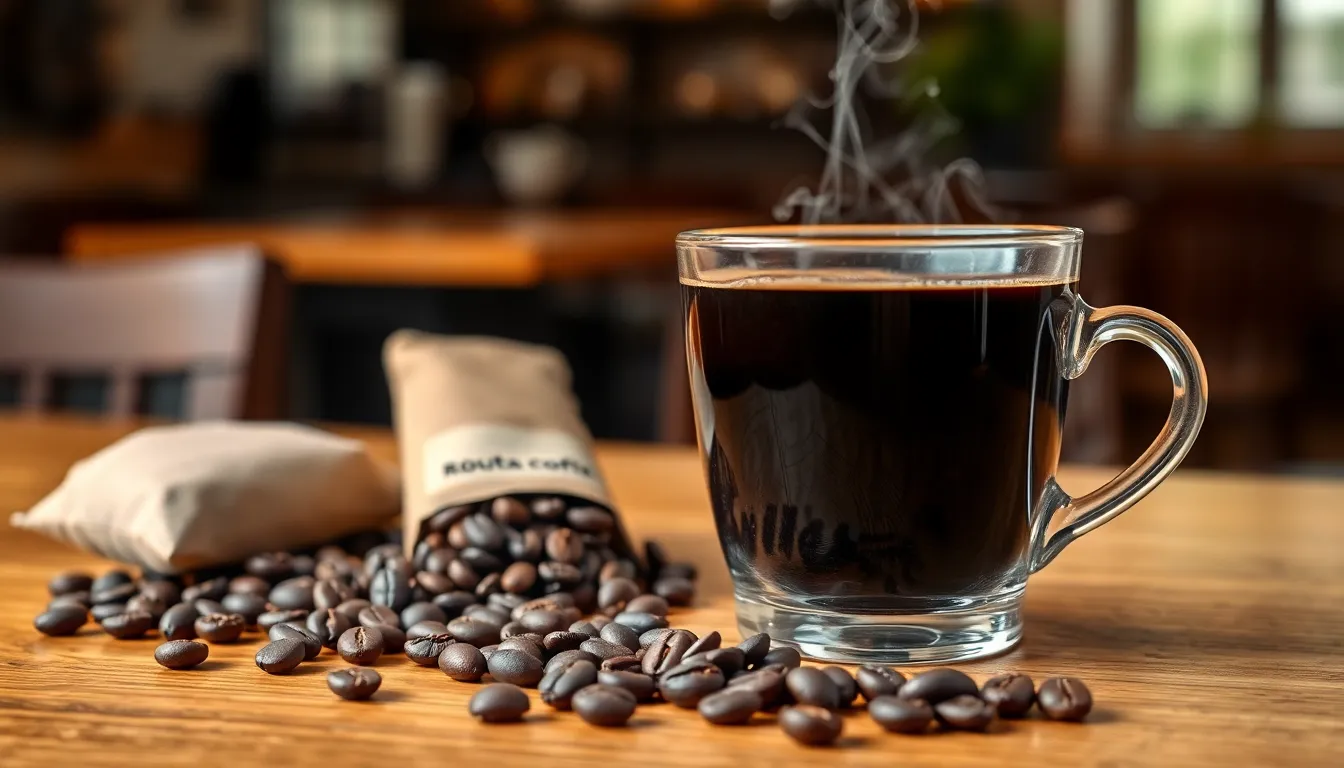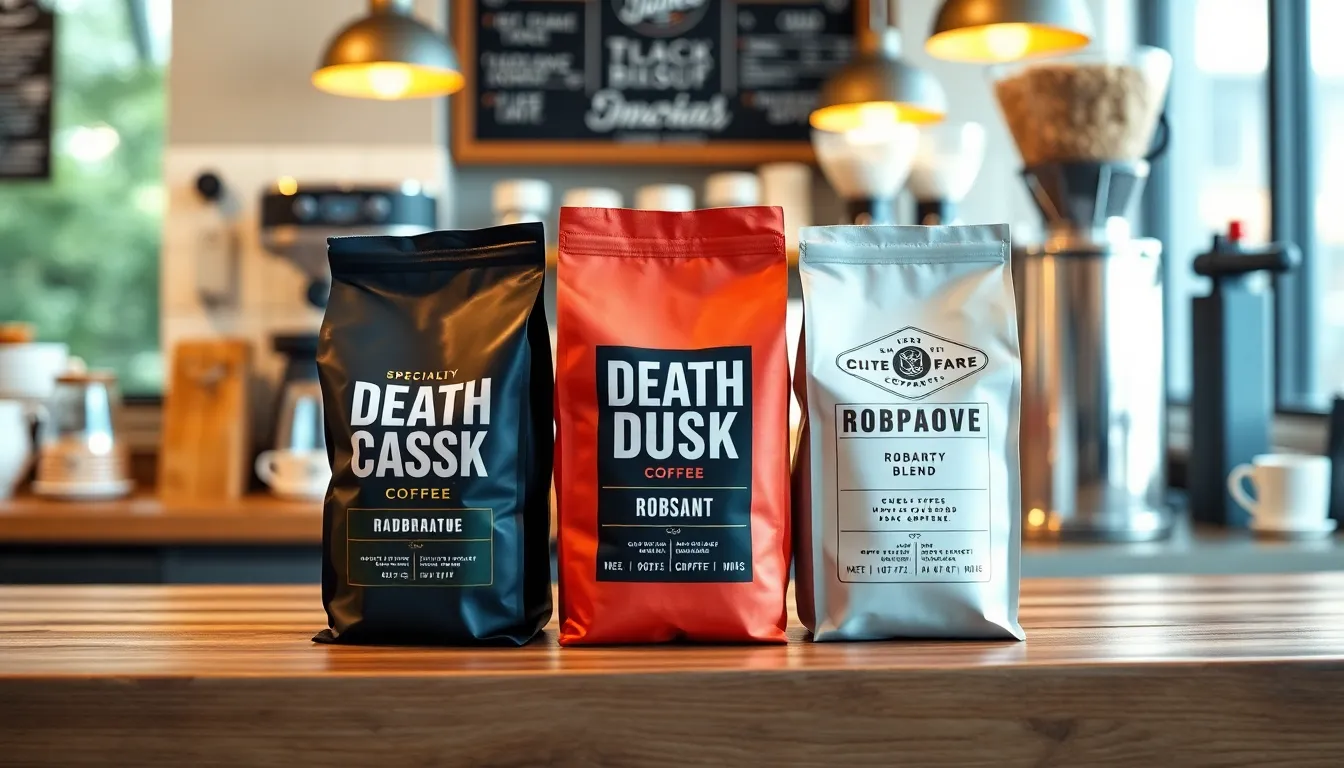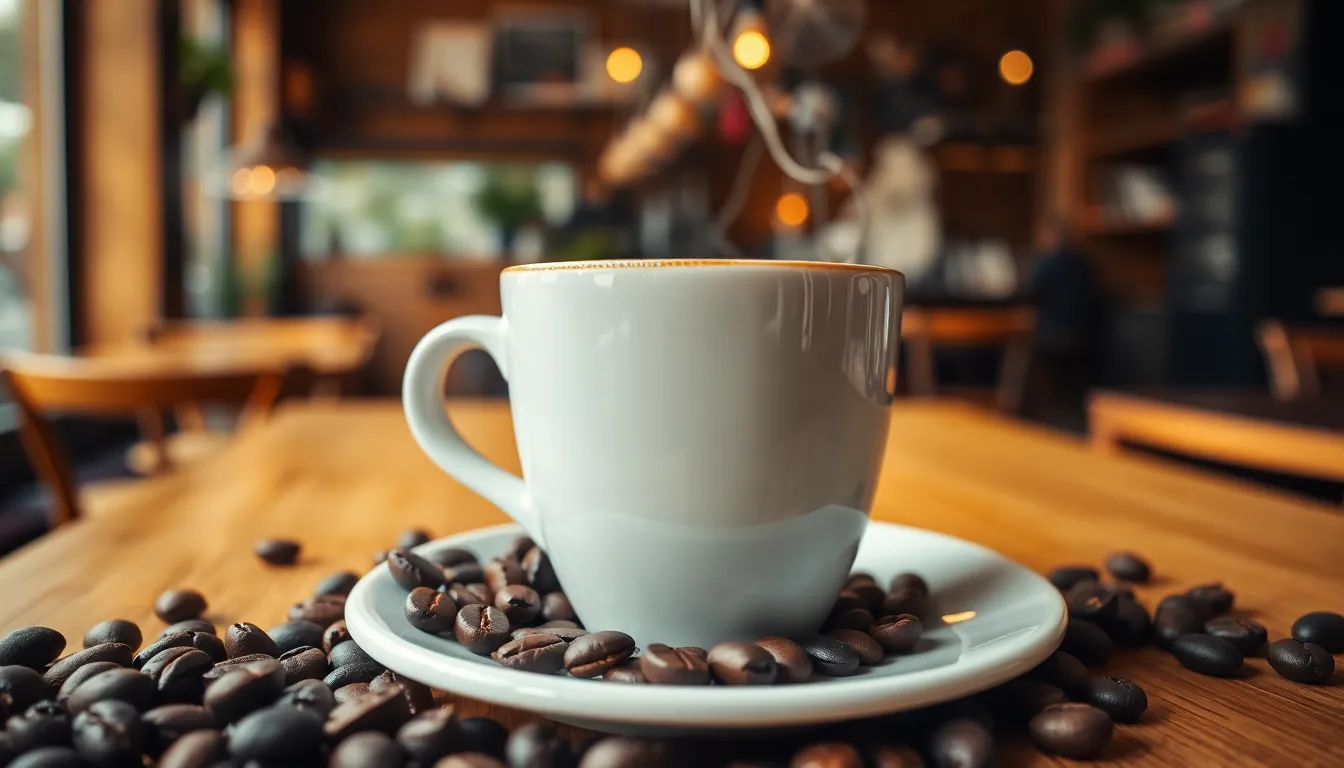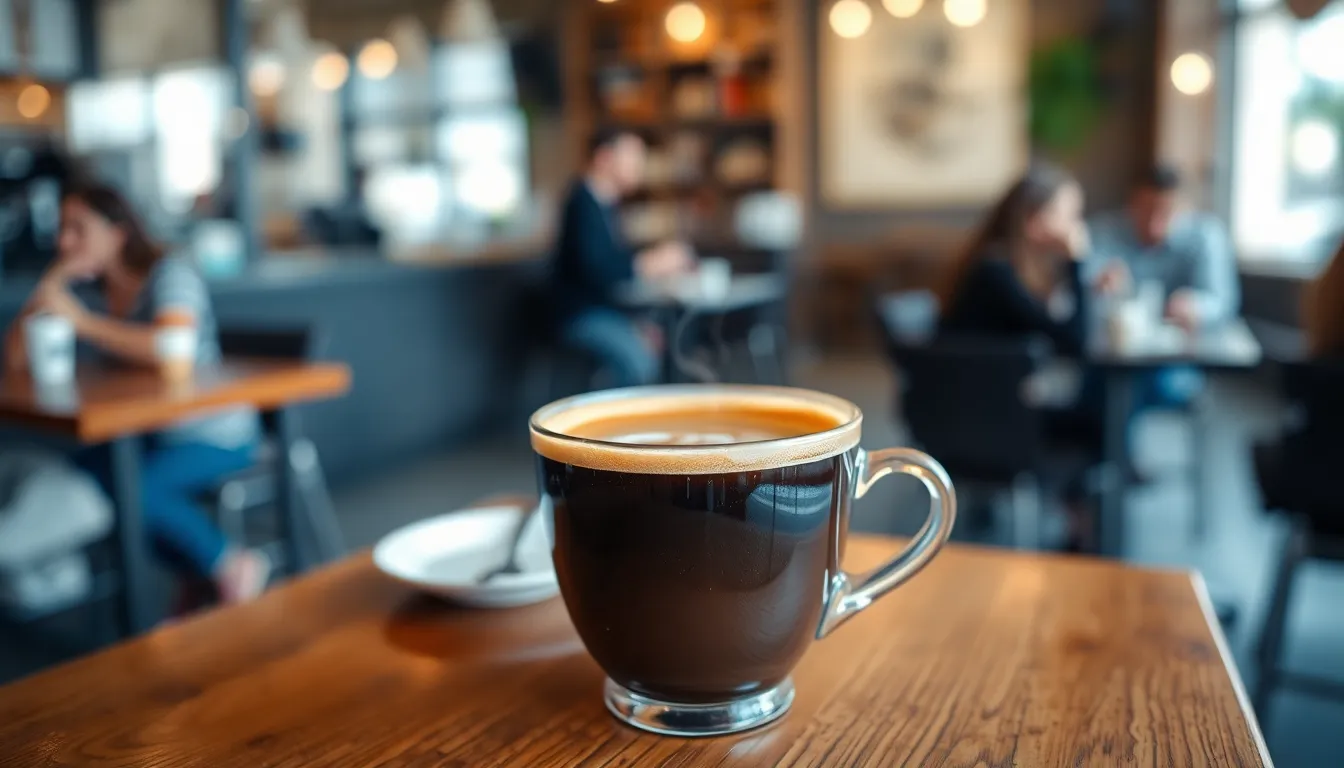Are you wondering which coffee has the most caffeine to jumpstart your morning? That first cup can make all the difference between sluggishly starting your day or hitting the ground running with energy and focus.
Not all coffees are created equal when it comes to caffeine content. The amount can vary dramatically depending on the bean type, roast level, brewing method, and serving size. Whether you’re looking for that extra boost to power through a busy workday or trying to moderate your caffeine intake, understanding these differences is essential for making informed choices about your daily brew.
Understanding Caffeine Content in Coffee
Caffeine content varies dramatically across different coffee types, with some containing nearly four times more caffeine than others. Your morning brew’s strength depends on multiple factors that influence how much of this stimulant ends up in your cup. Several key elements determine the final caffeine concentration in coffee, creating important differences between various brewing methods and bean selections.
Factors Affecting Caffeine Levels
Bean variety significantly impacts caffeine content, with Robusta beans containing approximately 2.2% caffeine compared to Arabica’s 1.2%. Roasting duration affects caffeine levels inversely – lighter roasts retain more caffeine than darker roasts even though common misconceptions. Brewing methods extract caffeine differently; espresso machines force hot water through grounds quickly under pressure, while cold brew steeps grounds in room temperature water for 12-24 hours, resulting in a highly caffeinated concentrate.
Water temperature plays a crucial role in caffeine extraction, with optimal extraction occurring between 195°F and 205°F. Brewing time directly correlates with caffeine content – the longer coffee grounds contact water, the more caffeine transfers to your drink. Grind size affects extraction rates; finer grinds have more surface area exposed to water, allowing for more complete caffeine extraction in shorter brewing times.
Caffeine Content by Coffee Type
| Coffee Type | Serving Size | Caffeine Content (mg) |
|---|---|---|
| Espresso | 1 oz (30ml) | 63-80 mg |
| Cold Brew | 16 oz (473ml) | 200-300 mg |
| Drip Coffee | 8 oz (237ml) | 95-165 mg |
| French Press | 8 oz (237ml) | 80-135 mg |
| Instant Coffee | 8 oz (237ml) | 30-90 mg |
| Decaf Coffee | 8 oz (237ml) | 2-15 mg |
Espresso delivers caffeine in a concentrated form even though its small serving size, packing 63-80mg in just one ounce. Cold brew contains significantly higher caffeine levels due to its extended extraction time, with a 16oz serving containing 200-300mg. Traditional drip coffee offers moderate caffeine content, typically providing 95-165mg per 8oz cup depending on bean selection and brewing parameters.
French press brewing creates a full-bodied cup with moderate caffeine content, usually containing 80-135mg per 8oz serving. Instant coffee contains less caffeine than most other preparations, offering only 30-90mg per 8oz cup. Decaffeinated coffee still contains small amounts of caffeine, typically 2-15mg per 8oz cup, which is approximately 97% less than regular coffee.
Factors That Affect Caffeine Levels in Coffee

Caffeine content in coffee varies significantly based on several key factors that influence the final concentration in your cup. Understanding these elements helps you make more informed choices about which coffee will deliver the caffeine kick you’re looking for.
Bean Type: Robusta vs. Arabica
Bean variety creates the most substantial difference in caffeine content among coffees. Robusta beans contain approximately twice the caffeine of Arabica beans, measuring around 2.2-2.7% caffeine by weight. These beans are frequently used in blends designed to deliver a stronger caffeine kick and more intense flavor profile. Arabica beans, in contrast, have a lower caffeine content of about 1.2-1.5% by weight. Coffee connoisseurs often prefer Arabica for its smoother, less bitter taste even though its reduced caffeine levels.
Roast Level Impact on Caffeine
Contrary to popular belief, roast level doesn’t significantly alter the caffeine content in your coffee. The roasting process affects flavor compounds more than caffeine concentration. Darker roasts may contain slightly less caffeine than lighter roasts due to the extended roasting time breaking down a small percentage of the caffeine molecules. This difference is minimal, but, and shouldn’t be your primary consideration when selecting coffee for its caffeine content. The bean type plays a much more important role in determining how much caffeine you’ll consume.
Brewing Method Differences
Your brewing method dramatically affects the final caffeine concentration in your cup. Vietnamese coffee, typically made with high-caffeine Robusta beans using a traditional phin filter, delivers one of the highest caffeine contents per serving among coffee preparations. Espresso preparation extracts caffeine efficiently under pressure, with a single shot containing approximately 63 mg of caffeine and a double shot providing 126 mg. Drip coffee contains around 95 mg of caffeine per 8 oz cup, though this can range from 70-140 mg depending on the beans used and brewing parameters. Cold brew methods, with their extended steeping times, often yield higher caffeine concentrations compared to traditional hot brewing techniques.
Highest Caffeine Coffee Drinks Ranked

Coffee caffeine content varies significantly across different preparation methods and bean types. The ranking below shows which coffee drinks pack the most punch when you’re looking for that extra boost.
Espresso and Espresso-Based Drinks
Espresso serves as the foundation for many high-caffeine coffee options. A single shot (1 ounce) contains approximately 63 mg of caffeine, while a double shot doubles that to about 126 mg. Many specialty coffee shops use blends mixing Arabica and Robusta beans for their espresso, with Robusta contributing significantly higher caffeine levels. These espresso blends often contain up to 40% Robusta beans, dramatically increasing the caffeine content. Espresso-based drinks like cappuccinos typically retain the caffeine content of their espresso base, providing around 63 mg per 8-ounce serving.
Drip Coffee Variations
Traditional black coffee brewed through drip methods contains approximately 95 mg of caffeine per 8-ounce cup. This brewing process extracts caffeine efficiently through hot water passing through ground coffee beans. Instant coffee offers a more convenient but less caffeinated option, averaging around 63 mg per 8-ounce cup. Robusta-based drip coffees deliver substantially more caffeine than those made with Arabica beans, containing about 2.2% caffeine by weight compared to Arabica’s lower concentration.
Cold Brew’s Caffeine Content
Cold brew coffee provides one of the highest caffeine concentrations available in coffee drinks. The standard cold brew contains roughly 100 mg of caffeine per 8-ounce serving, with the extended steeping process (12-24 hours) allowing for maximum caffeine extraction. Nitro coffee, a nitrogen-infused cold brew variant, offers even more caffeine at approximately 125 mg per 8-ounce serving. The nitrogen infusion doesn’t add caffeine but creates a smoother, creamier texture that complements the bold caffeine content, making it the top choice for those seeking maximum energy from their coffee.
| Coffee Type | Typical Caffeine per 8 oz | Notes |
|---|---|---|
| Nitro Coffee | ~125 mg | Cold brew infused with nitrogen |
| Double Espresso | ~126 mg | Two shots of espresso |
| Cold Brew Coffee | ~100 mg | Long steep time, varies by ratio |
| Drip Black Coffee | ~95 mg | Standard brewed coffee |
| Single Espresso Shot | ~63 mg | Concentrated coffee |
| Instant Coffee | ~63 mg | Freeze or spray-dried brewed coffee |
Specialty Coffee Brands With High Caffeine

Specialty coffee brands have taken caffeine content to new heights, offering options that pack significantly more punch than your typical morning brew. These brands specifically formulate their products to maximize caffeine content, often using strategic bean blends and roasting techniques to achieve stimulation levels far beyond average coffee.
Death Wish and Other High-Octane Options
Death Wish Coffee stands as the undisputed champion of high-caffeine specialty brands, delivering an impressive 728 mg of caffeine per 12 oz bag. This potent brew achieves its stimulating effects through a strategic blend of robusta and arabica beans, creating a caffeine concentration that substantially exceeds typical arabica-based coffees. DEAD OR ALIVE COFFEE No3 represents another formidable option in the high-caffeine category, utilizing 100% robusta beans to deliver maximum stimulation. Nguyen Coffee Hanoi Peaberry Robusta similarly harnesses pure robusta beans, which naturally contain 2-3 times more caffeine than arabica varieties, making it an excellent choice for those seeking intense energy boosts. These specialty brands cater specifically to coffee enthusiasts who prioritize caffeine content above all else, offering answers for mornings when standard coffee simply won’t suffice.
Chain Coffee Shop Comparisons
Chain coffee shops vary dramatically in the caffeine content they deliver per serving. Costa Coffee leads UK chains with up to 325 mg of caffeine in their large coffees, significantly outpacing competitors like Greggs (197 mg) and Pret A Manger (180 mg). Caffe Nero offers a more moderate 110-115 mg per serving. American chains like Starbucks provide substantial caffeine kicks, with their Pike Place Roast delivering approximately 310 mg in a 16 oz (grande) serving. Dunkin’ Donuts competes closely with Starbucks in terms of caffeine content per cup in the US market. Cold brew offerings at major chains contain particularly high caffeine levels, especially when robusta beans are incorporated into their blends. The striking difference between UK Starbucks (about 66 mg per small cup) and US Starbucks (up to 400 mg for a 20 oz serving) demonstrates how caffeine content can vary significantly even within the same chain depending on location, bean selection, and roasting practices.
| Brand/Chain | Caffeine Content (per serving) | Notes |
|---|---|---|
| Death Wish Coffee | 728 mg per 12 oz bag | Robusta-arabica blend |
| Costa Coffee (UK) | Up to 325 mg | Large size |
| Starbucks (US) | ~310 mg (16 oz) | Pike Place Roast |
| Greggs (UK) | 197 mg | Standard serving |
| Pret A Manger (UK) | 180 mg | Standard serving |
| Dunkin’ Donuts (US) | High (comparable to Starbucks) | Various offerings |
Health Considerations With High-Caffeine Coffee

Understanding the health implications of high-caffeine coffee consumption is essential for coffee enthusiasts who enjoy stronger brews like Robusta-based drinks. Monitoring your caffeine intake helps balance the benefits of energy and alertness with potential side effects that can occur from excessive consumption.
Recommended Daily Caffeine Limits
Most health authorities recommend limiting caffeine intake to 400 mg per day for healthy adults. This equates to approximately four 8 oz cups of regular brewed coffee or about three 8 oz cups of Robusta-based coffee. Pregnant women, adolescents, and people with certain health conditions typically need lower limits—often around 200 mg daily. Tracking your consumption becomes particularly important when enjoying high-caffeine options like Vietnamese coffee or specialty brands such as Death Wish Coffee, which contains 728 mg per 12 oz serving.
Potential Benefits and Risks
Coffee’s caffeine offers several documented benefits when consumed in moderation. Regular coffee drinkers often experience improved alertness, enhanced cognitive function, and increased physical performance during workouts. Many studies link moderate coffee consumption to reduced risk of certain diseases, including Parkinson’s, type 2 diabetes, and some liver conditions.
Excessive caffeine intake, but, brings notable risks. Consuming more than the recommended 400 mg daily limit frequently leads to insomnia, increased heart rate, digestive issues, and heightened anxiety. Coffee drinkers who regularly consume high-caffeine varieties like those made with Robusta beans may develop caffeine dependence, experiencing withdrawal symptoms like headaches and irritability when they skip their usual cup. Individual sensitivity varies significantly—what affects one person minimally might cause considerable discomfort for another.
People with certain medical conditions should exercise particular caution with high-caffeine coffee. Those with hypertension, heart arrhythmias, anxiety disorders, or gastroesophageal reflux disease (GERD) often find that high-caffeine coffee exacerbates their symptoms. Monitoring your body’s response after consuming stronger coffees like espresso or cold brew helps determine your personal tolerance level.
Conclusion
Now you know which coffees pack the most caffeine punch. Whether you’re reaching for a jolt with Death Wish Coffee’s 728 mg or keeping it moderate with a standard drip brew you can make informed decisions about your daily cup.
Remember that bean type makes the biggest difference with Robusta delivering nearly twice the caffeine of Arabica. Your brewing method also matters significantly with cold brew and espresso extracting more caffeine than other methods.
For maximum energy choose specialty high-caffeine brands or certain chain offerings like Costa Coffee or Starbucks. Just be mindful of the 400 mg daily caffeine limit for healthy adults to enjoy your coffee’s benefits without unwanted side effects.
Frequently Asked Questions
What factors affect caffeine content in coffee?
Caffeine content in coffee varies based on four key factors: bean type (Robusta contains more caffeine than Arabica), roast level (though the difference is minimal), brewing method (pressure and steeping time affect extraction), and serving size. Understanding these factors helps you make informed choices about your coffee consumption, whether you’re seeking an energy boost or trying to manage your caffeine intake.
Which coffee bean has more caffeine: Arabica or Robusta?
Robusta beans contain significantly more caffeine than Arabica beans. Robusta typically contains about 2.2% to 2.7% caffeine by weight, while Arabica contains only 1.2% to 1.5%. This means Robusta coffee can deliver nearly twice the caffeine kick of Arabica, making it the preferred choice for high-caffeine coffee products.
Does dark roast coffee have more caffeine than light roast?
Contrary to popular belief, roast level has minimal impact on caffeine content. Dark roasts may actually contain slightly less caffeine because the extended roasting process breaks down some caffeine molecules. However, the difference is negligible, and bean type (Arabica vs. Robusta) has a much more significant impact on caffeine levels than roast profile.
Which brewing method extracts the most caffeine?
Cold brew typically extracts the most caffeine because of its extended steeping time (12-24 hours), resulting in 200-300mg per 16oz serving. Espresso machines extract caffeine efficiently under pressure (63-80mg per 1oz shot), while drip brewing falls in the middle range (95-165mg per 8oz cup). French press delivers 80-135mg per 8oz, and instant coffee contains the least (30-90mg per 8oz).
How much caffeine is in a shot of espresso compared to regular coffee?
A single espresso shot (1oz) contains approximately 63mg of caffeine, while an 8oz cup of drip coffee typically contains 95-165mg. Although the total caffeine in drip coffee is higher, espresso has a more concentrated amount per fluid ounce. This explains why espresso delivers a quicker energy boost despite its smaller serving size.
Which coffee brand has the highest caffeine content?
Death Wish Coffee leads with approximately 728mg of caffeine per 12oz bag, achieved through a blend of Robusta and Arabica beans. Other high-caffeine options include DEAD OR ALIVE COFFEE No3 and Nguyen Coffee Hanoi Peaberry Robusta, which primarily use Robusta beans for maximum caffeine content. These specialty brands specifically target consumers seeking an intense caffeine boost.
How much caffeine is in decaf coffee?
Decaffeinated coffee still contains small amounts of caffeine, typically ranging from 2-15mg per 8oz cup. The decaffeination process removes approximately 97% of caffeine, not 100%. Those extremely sensitive to caffeine or with medical conditions requiring strict caffeine restriction should be aware that even decaf coffee isn’t completely caffeine-free.
How does caffeine content vary between coffee shop chains?
Caffeine content varies significantly between chains. Costa Coffee leads UK chains with up to 325mg in large coffees, while Starbucks offers around 310mg in a 16oz serving in the US. These variations result from differences in bean selection, roasting practices, and brewing methods. Even the same chain may have different caffeine levels in different locations.
What is the recommended daily limit for caffeine consumption?
Most health authorities recommend limiting caffeine intake to 400mg per day for healthy adults (equivalent to about 4 cups of regular coffee). Pregnant women should limit intake to 200mg daily, while those with certain health conditions may need stricter limits. Exceeding these guidelines may lead to side effects like insomnia, increased heart rate, and anxiety.
What are the health benefits of caffeine in coffee?
Moderate caffeine consumption offers several benefits, including enhanced alertness, improved cognitive function, increased physical performance, and potential protection against certain diseases like Parkinson’s and type 2 diabetes. Coffee also contains antioxidants that contribute to its health benefits. For most healthy adults, 1-3 cups daily provides these benefits without significant side effects.

